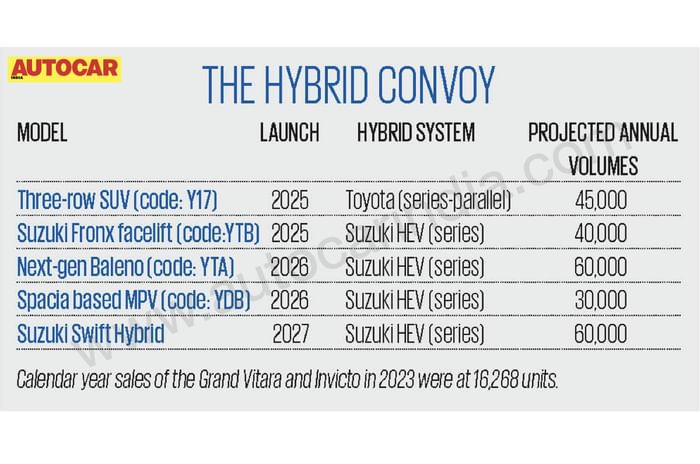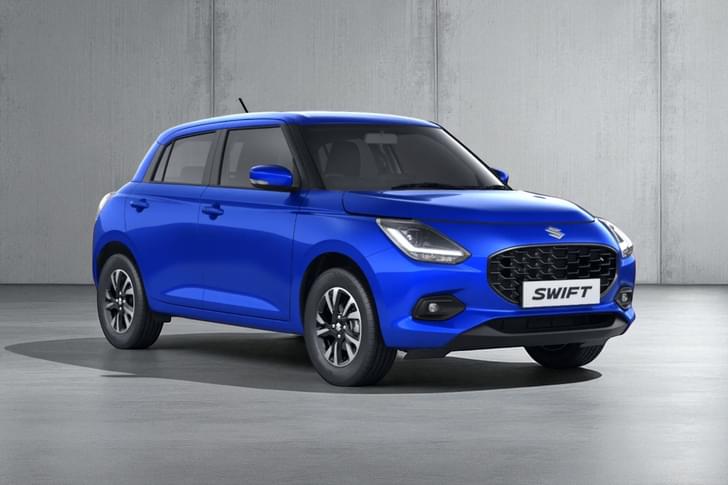While the automotive industry rushes headlong into electrification, the reality is that hybrids are fast finding favour with car buyers and outselling EVs, and that too with a very limited choice of models. The jump in demand for hybrids has been driven by Maruti Suzuki and Toyota, who, unlike most other automakers, aren’t rushing into the EV game. Maruti Suzuki has instead hedged its bets with a multi-fuel strategy that includes EVs, CNG, biofuels and, significantly, hybrids.
Maruti Suzuki, in fact, is betting big on hybrids, encouraged by the terrific response to the Grand Vitara Hybrid, which uses Toyota’s famed hybrid powertrain and accounted for about 15 to 20 percent of total Grand Vitara sales in 2023. The Innova Hycross-based Invicto MPV – launched in 2023 – and a three-row version of the Grand Vitara (code: Y17) coming in 2025 will further expand Maruti Suzuki’s hybrid play.
The big news is that Maruti Suzuki has huge plans to exponentially increase hybrid volumes with offerings in mass segments using hybrid variants of the Fronx, Baleno, Swift and a small MPV, which are all under development. The masterstroke, however, is that the company won’t use Toyota’s series-parallel hybrid system but is instead developing an in-house and cheaper series hybrid powertrain that is essentially a range extender.
Maruti Suzuki’s new series hybrid powertrain (code: HEV) will be significantly cheaper to produce than a series-parallel and parallel-only hybrid, which is the main reason why the carmaker chose this route to counter the inherent high cost of a powertrain that includes an IC engine, electric motor and battery. Also, the government has thus far refused to give hybrids any tax benefit and the high rate of 43 percent GST compared to just 5 percent for EVs is the main cost barrier. To reduce the cost impact, Maruti Suzuki has found a solution with a series hybrid.
What is a series hybrid powertrain?
So what exactly is a series hybrid and why is it cheaper to build? The petrol engine in a series hybrid system serves only as a generator or range extender, thus instead of directly propelling the vehicle, it produces electricity to power an electric motor that, in turn, drives the wheels.
It is, thus, relatively simple because the electric motor is the only power source driving the wheels – just like in an EV – and the motor draws electric power from either a small battery pack or from a generator run by the petrol engine. The series hybrid system is also called a range extender hybrid because the IC engine acts as a generator to keep recharging the EV’s battery pack. The Nissan Note is one example of a range extender series hybrid vehicle, which was being tested in India.
Advantages of a series hybrid
There are several advantages of a series hybrid, which makes it attractive as a mass-market option. Firstly, the absence of a direct mechanical link between the IC engine and wheels simplifies the overall design of the powertrain, thereby making it a more cost-effective hybrid solution, as well as potentially reducing maintenance costs, and improving reliability – all prerequisites of the small-car segment.
With less mechanical losses, the layout in a series hybrid system offers optimised efficiency in city driving, with the system excelling in stop-and-go traffic scenarios, typical of urban driving environments.
However, series hybrids are not particularly efficient on the highway, since the electric motor is the primary source of propulsion, the internal combustion engine (ICE) may need to work harder to generate electricity. So, for long-distance driving, parallel hybrids can be more efficient at higher speeds and constant loads, since both the internal combustion engine and the electric motor can work together to propel the vehicle.
So, though the parallel hybrids feel nicer to drive, they require more complex transmission systems to allow both the internal combustion engine (ICE) and electric motor to drive the wheels independently or together. This complexity is one of the main reasons why parallel hybrids are more expensive.
Maruti Suzuki’s hybrid system
The power source for Maruti Suzuki’s new range of HEV-based series will be the all-new Z12E, three-cylinder engine. The compact Z12E will act as a generator to charge a 1.5-2kWh battery pack or drive an efficient electric motor that, in turn, drives the front wheels.

Maruti Suzuki’s HEV series hybrid powertrain will debut in the facelifted Fronx (code: YTB) followed by the next-gen Baleno (code: YTA) in 2026. The next-gen Swift (code: YEA), which is due for launch in the first half of this year, is also expected to come with a hybrid option, though not before 2027. So until then, this very popular hatch will be a petrol-only model. Other models in line for the HEV system are the Spacia-based compact MPV (code: YDB) and the next-gen Brezza, which will come with hybrid power only in 2029.
By the end of the decade, Maruti Suzuki could have as many as over half a dozen models and models with a potential volume of eight lakh units per annum or 25 percent of its total volumes powered by hybrid tech, which includes Toyota’s 1.5-litre parallel-hybrid powertrain and its own HEV 1.2-litre series hybrid system.
Maruti Suzuki hybrid fuel efficiency
In a series hybrid, as the engine only runs to produce electricity and never directly takes on the driving load, it is most often running in the prime fuel-efficient rev range. Hence, Maruti’s HEV-powered cars are expected to give exceptional fuel economy to the tune of 35-40kpl on the test cycle and will also be a key technology to meeting future CAFE targets, which are due to get stricter in 2027.
Maruti Suzuki may have botched up its diesel strategy by exiting the diesel market earlier than it should have and also losing the first mover advantage in the EV race. But in the hybrid race, it is quietly zooming ahead whilst most of its rivals don’t even have a plan. And in this decade, the hybrid race could turn out to be the most important one to win.
With technical inputs from Mayank Dhingra and Sergius Barretto.
Also see:
Next-gen Maruti Dzire spied for the first time
Maruti Fronx gets up to Rs 83,000 off on MY2023 stock
Maruti Grand Vitara gets up to Rs 75,000 off on MY2023 stocks


































